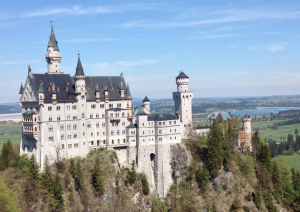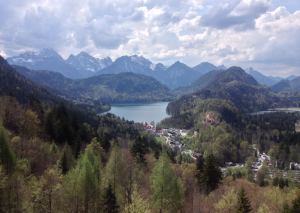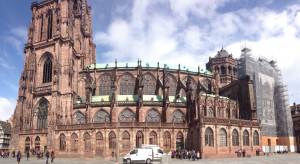Castles, Lessons, and Goodbyes
Whelp. The semester is official over and what a wild ride it has been. Ultimately, I still can’t believe it’s over and that while I remain in Prague, most of everyone else has either gone home or off the explore Europe on their separate adventures. But we’ll save the sappiness for later, shall we?
I rounded off my travels on the European continent in Munich, Germany (sort of… I only went to see the Neuschwanstein Castle, which learning to spell I consider one of my greatest accomplishments the semester) and the city of my childhood, Strasbourg, France.
Anyone how knows me can attest to the fact that I don’t just “like” things, I obsess. Such things include, castles, dragons, Harry Potter, Benedict Cumberbatch, the color of the sky during a sunset, cheese ramen, British television… my list of infatuations is rather extensive. When I realized that the castle to end all castles was located within my reach, naturally it became mandatory that I be there. The Neuschwanstein Castle is mostly famous for being the inspiration for Disney’s Sleeping Beauty Castle, the center monument of any Disneyland theme park (another one of my numerous obsessions) and due to Ludwig II’s untimely death, has never been fully completed. However, the lack of completion did little to stem the awe pouring out of me the minute I looked up at it for the first time (second time according to my mum, curse the vapid memory of a six year old). To the say the castle was magnificent does not do it justice. The surrounding countryside full of snow- capped mountains and flowered hills reminded me of the opening scene from the Sound of Music and the entire landscape seemed to come alive with the sun. I decided on the train ride there that the German countryside is by far one of the most beautiful pieces of scenery upon which I’ve had the privilege to lay my eyes. But that castle, nestled in the mountains, appeared stoic and impervious to any element the winds of change may throw towards its walls. Such grandeur fit perfectly with the strong mountains and clear lakes residing in the area and the cute little village at the castle’s foot completes the fairytale- esque feel that rolls off the scenery. I’ll be back there. Hopefully to live. That’s the plan.


After the program officially ended, I decided to go back to my roots and revisit the part of France in which I lived 13 years ago. My memories of my time in Strasbourg and the little village, Reichstett, just outside the city are muddy to say the least. However, walking around my old house and elementary school managed to pull out some long forgotten details, such as when I tried to sleep in the backyard one night because I was upset with my parents or watching my purple- housed neighbor’s turtles from my bedroom window. The town itself felt much smaller than I remember, which probably is due to the fact I was only 4 feet tall during my last visit and therefore everything around me felt monstrous. Strasbourg’s Alsatian charm, however, proved just as beautiful, the bread still warm and delicious, and the weather as cold and rainy as when we were there. I’m a tad ashamed to say that my first thought on seeing the grandiose Strasbourg Cathedral was that it put the St. Vitus of Prague to shame, but only slightly. Another fact I came faced with was the horridness of my French. How sad it is to know that when I was 6, I could speak both French and English and now, at 19, I can hardly put a proper sentence together (I’m sorry Madame Shepard, do not think my forgetfulness is a reflection on your teaching but my own folly). Regardless, the houses and streets of Strasbourg charmed me more now that I could fully appreciate the uniqueness of their designs. I particularly enjoyed visiting the historical museum, mostly because they had various funny hats and Medieval knight helmets for me to try on and buttons to push (when it comes down to it, I really am still 6 years old). While sitting in the sun on the bank of the canal that encircles the center, I felt at peace with my decision to revisit France again at the end for it brought my European adventures full circle.

The hardest part of the semester was not the initial arrival, adjusting to new teaching methods, or even learning to navigate a brand new, unknown city without any understanding of the language. Did all these things come with their own challenges? Of course, but they proved surmountable in the end. For me, the most difficult part of the semester has been the end, the goodbyes. Not just to the city (I’m actually still in Prague until Wednesday) but to the friends and memories that we made together. Parting with my roommates and our apartment has left me with an empty feeling; knowing that we all won’t be together again in the same way we were for the last 4 months. I miss them more than words can say. The last few days of the program can be summed up with this; cry cry cry tears tears tears, boat cruise, “this isn’t goodbye, just see you later”, paddle boat racing, last meal of goulash and dumplings, split second of karaoke, Sherlock slumber party, more tears, more crying. I’m not exaggerating this bit in the slightest. But, in the words of A. A. Milne, “How lucky I am to have something that makes saying goodbye so hard.”
Now looking back on everything, I’ve come up with several notes for future reference as well as final lessons I’ve learned from the entirety of my experience:
Tips/ Final Lessons:
1. Write everything you do down. The biggest lie I’ve told myself is, “I don’t have to write this down, I’ll remember.” Ha, yeah. The brain can be a scumbag. Notes will prove incredibly beneficial when you’re telling your friends all your cool stories.
2. Trains are probably the most entertaining way to travel. Buses are usually cheaper but…. trains. I understand Sheldon Cooper’s obsession with them, now.
3. At least attempt to systematize packing. My method is usually just “Oh hey, let’s stuff everything in the suitcase without rhyme or reason”, which results in me digging through it to find something like toothpaste at the bottom. And then repacking.
4. Food on your plate looks weird? Eat it. Seriously. “But.. but.. its a tiny squid.. it looks-” No. Try it.
5. Best non-Czech related cuisine? Kebab. Kebab kebab kebab. If you go to Europe and don’t eat a döner kebab, we can’t be friends.
6. USAC program directors are some of the best people on this planet. I mean, who else climbs up on a horse statue in the middle of Budapest to get a picture of the program? Or dances around the moving bus wearing a necklace of paprika holding a loaf of bread the size of a small child? Only the best, that’s who.
7. Going overseas in one the scariest adventures you can have, especially when you go without knowing anyone. You might wake up the first day thinking, “What on earth have I done?” But let me tell you, it’s worth it. All of it. The fear and anxiety are nothing compared to the exciting adventures you will have or the strength of the friendships you will make. If I can do it, you can too, trust me on that one.
Overall, my semester abroad has been the most terrifying, exhilarating, and challenging several months of my 19 years. The idea now of going back to the real world and real life fills me trepidation. Yet, all good things must come to an end. But it’s not the end, not really anyways. The memories and knowledge I have gained throughout this experience will stick with me, long after I’ve readjusted to life back on the other side of the ocean.
Ending remarks, the motto of our program:
Live, laugh, love. Never die, frown, hate.